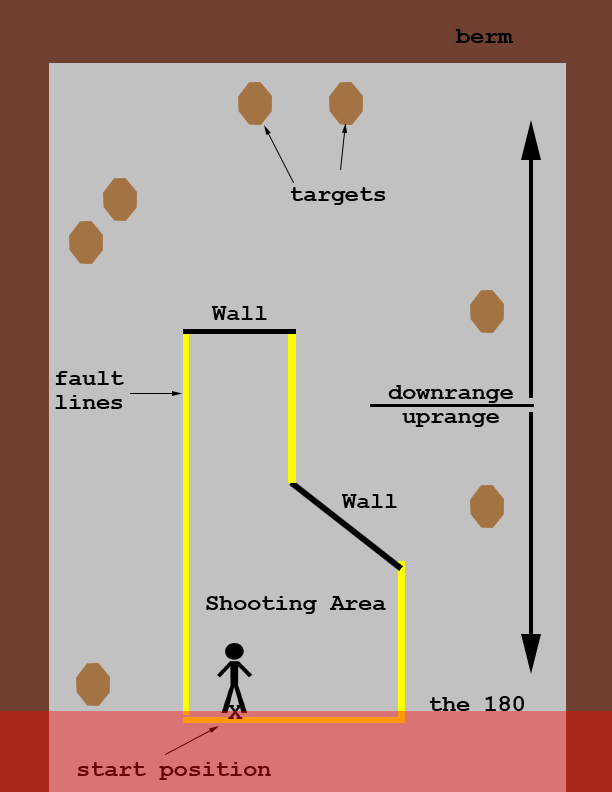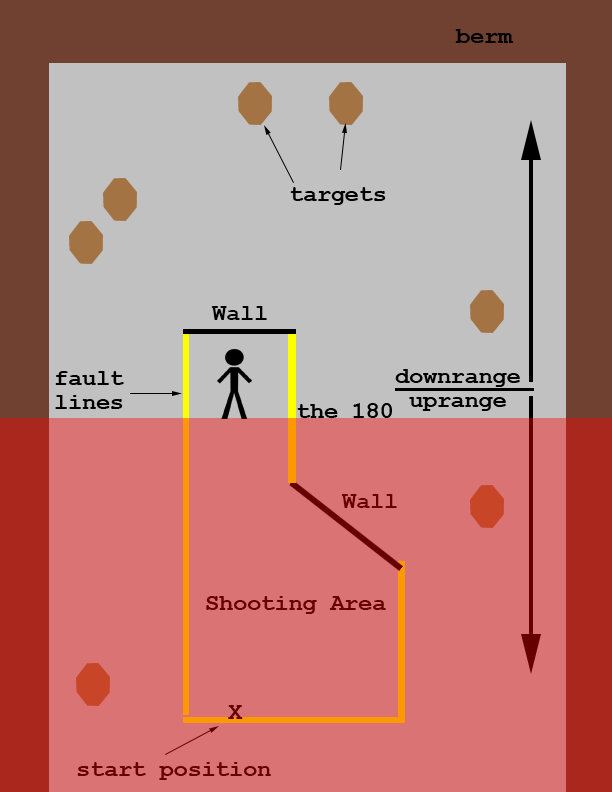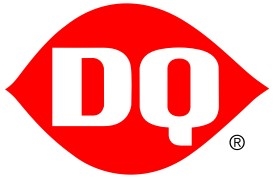Basic Safety
Hearing and eye protection is mandatory for all shooters and spectators.
You are expected to understand and practice basic gun handling safety. Violations will result in a disqualification from the match. Here is a refresher video.
Cold Range
Note: the terms Range Officer (RO) and Safety Officer (SO) are used interchangeably.
- Cold Range means everyone is unloaded unless they are actively shooting.
- At no time may you handle your firearm on any part of the range, except as specified below. Violating a safety rule will result in a match disqualification. Egregious violations may lead to your expulsion from the range, and possible exclusion from future activities with DAPS.
- NO loaded guns on the range. Please do NOT show up with a loaded gun in your holster or bag. Unload just prior to arriving or, if you must, find a match official or range officer to safely instruct you on unloading your firearm.
- Guns are to remain unloaded and in a holster or bag at all times unless under the direct observation of a RO.
- You may handle your unloaded gun only in the designated safe areas, or under the direction of a Range Officer.
- Never handle or load ammunition in the Safety Area. Having magazines on your belt is ok but you may not remove them in the Safety Area. To be extra careful new shooters should leave their magazines in their bags.
- Ammunition can be handled and loaded anywhere except for the safe area.
- Your car is NOT a Safe Area. Please holster/unholster your gun in the safe area.
- Please don't bring your gun into the business office of the Elm Fork Range. Please leave your gun, with the slide locked back, in the safe area. We'll keep an eye on it for you.
- If you need to fire your gun as part of a functional or safety check, find a Range Officer to assist you. You may NOT load and/or shoot your gun without RO supervision. This rule is inviolate.
Safety Area
The range will have a designated Safety Area where you can unbag your (already unloaded) firearm. Make sure it is unloaded before you bring it to the range. If there is no marked Safety Area we will use the side of a berm but wait and get confirmation before unbagging your gun.
If you have a CHL you must still be unloaded during the match. Either unload prior to arriving or immediately find the match director or safety officer to help you unload until the match is over.
| Safety Area | Everywhere Else | |
|---|---|---|
| Gun | ||
| Ammo |
You may adjust all your other gear anywhere. However, if you need to adjust your belt or holster please go to a Safety Area, bag your gun, move away from the Safety Area, then adjust your belt, then return to the Safety Area to gun up.
Important Range Commands
You may want to mentally practice these commands at home (with an unloaded weapon).
Make ready
- This command is given when it is your turn to shoot.
- Do not unholster or load your weapon before being given this command!
- You should ask any questions before loading your gun.
- You should face down range (towards the back of the stage, away from the spectators) to draw your gun, keeping your finger off the trigger and the muzzle down range. Remember to turn to face downrange even if the start of the stage is sideways or facing uprange.
- Load your gun to normal capacity for your division, unless otherwise specified in the COF. For example, if you shoot SSP or Production you load 10+1 which means 1 in the chamber and 10 rounds in the magazine. If you are unsure about round count then just ask the RO.
- Re-holster the gun and assume the specified start position.
- Take a couple deep breaths and focus on your start.
Are you ready?
- This question is asked by the Range Officer when you are at the starting position.
- If you are not ready say "No". The RO will wait until you are ready.
- The lack of a negative response will indicate your readiness. Most shooters nod or just stay still.
Stand by
- The BEEP from the timer will happen a few seconds after this command.
- You may start your course of fire after the beep.
If you are finished, unload and show clear
- This command is given when it appears you have finished a course of fire.
- Take your finger off the trigger, keep the muzzle pointed downrange.
- Unload your magazine. Place the magazine in your pocket, magazine pouch or let it drop to the floor. For revolvers, open the cylinder and remove the cases and remaining rounds.
- Pull the slide back and make sure you clear the chamber.
- The Range Officer will also inspect for a clear chamber but it is your responsibility for an empty chamber.
- Please take your time, you are not being timed.
If clear, hammer down, holster
- Drop the slide, point the gun at the berm, pull the trigger, engage any safety mechanism and re-holster your gun. For revolvers, close the cylinder and holster.
- Do not do anything until your gun is holstered! You can pickup your magazines or bullets after you are holstered.
- Please take your time, you are not being timed.
Range is clear
- This is the final command given when your gun is clear and holstered.
- Nobody on the range must advance for scoring and/or taping until this command is given.
- Now the targets may be scored and taped for the next shooter.
Other Commands
STOP!
- Immediately stop shooting.
- Point your gun down range and wait for instructions from the safety officer.
- This command may be given because of a range equipment failure, shooter equipment failure, or safety issue.
Muzzle
- This command is given because your muzzle is approaching an unsafe direction, and is only a courtesy call. If you break 180 degrees in an USPSA match, you will be disqualified from the match.
- You should point your muzzle down range and continue shooting the stage.
- A gross muzzle violation such as sweeping yourself or somebody else will result in a match disqualification.
The 180 Degree Safety Rule
| A sample USPSA stage | The red area is beyond the 180. Pointing your gun into the red area for any reason - while reloading, clearing a malfunction, slipping and falling - is a disqualification. | The 180 moves with the shooter and remains parallel to the back of the berm. Trying to shoot at the targets behind the shooter is a violation of the 180. |

|

|

|
As a new shooter learn to spot some problematic situations and ask the RO for any clarifications. While not required the ROs and shooters will often warn each other of potential problems. Watch out for some of these situations.
- When reloading while moving or facing left for a right handed shooter and vice versa for a left handed shooter.
- When moving backwards.
- When trying to guide your gun around a wall. Don't steer the gun with your hands, move your arms and entire upper body.
- When pulling back after leaning around a wall.
- When pulling back after shooting through a port. Move straight out instead of trying to curl around.
- When forgetting a target.
- Shooting at targets to the side while moving too fast.
Sweeping
Sweeping is allowing the muzzle to cross part of your body or someone else's. Watch out for some of these situations.
- When opening a door, window or port. Hold the gun well away from the activating device. Some stages require you to point your gun to a certain spot while opening a port.
- When adjusting a cover garment.
- When trying to clear a malfunction.
Accidental Discharge
In a nutshell, don't discharge your firearm unless pointed at a target. Keep your finger off the trigger until your sights are on target.
Dropping a Firearm
If a gun starts to fall, let it fall. Do not attempt to grab it. Stay away from the gun after it has fallen. Notify a Safety Officer and they will clear the area, make the weapon safe, and return it to you. Depending on the circumstances the drop may result in a match disqualification. Regardless, do not attempt to grab a falling weapon.
Reloading your gun
- Keep your finger out of the trigger guard during a reload.
- Keep the muzzle of the gun pointed downrange.
- Do not break the 180 while reloading. Most right handed shooters point the gun to the left while reloading. If you are already facing left you may break the 180. Left handed shooters should be watchful of the opposite.
- It's better to go slow and safe than to be disqualified.
 Disqualifications =(
Disqualifications =(
Unfortunately we all have the potential to be disqualified. Some of us were disqualified in our first match but we came back!
- Safety violations will result in a DQ. No one wants to see someone end their day early but safety comes first.
- If you are disqualified you should take a deep breath and take a few moments to calm down.
- Go to a Safety Area and bag your gun.
- You are done shooting for the day. You can choose to leave, stay and watch or even help but no more shooting for the match.
- Disqualified shooters receive no score for the match.
 Have fun!
Have fun!
- The safety rules are there so we all have fun and go home safely.
- When everyone is safe then we can all focus on the fun parts of shooting.

